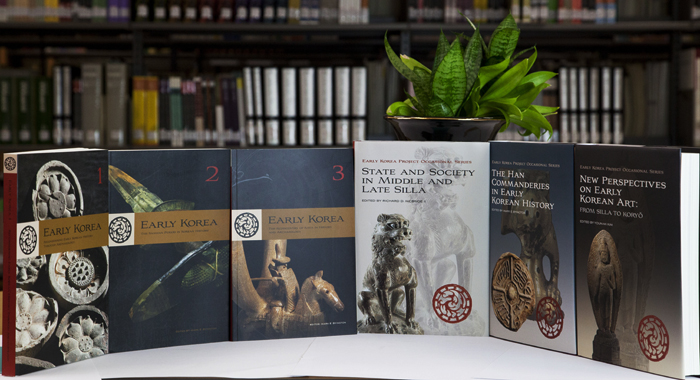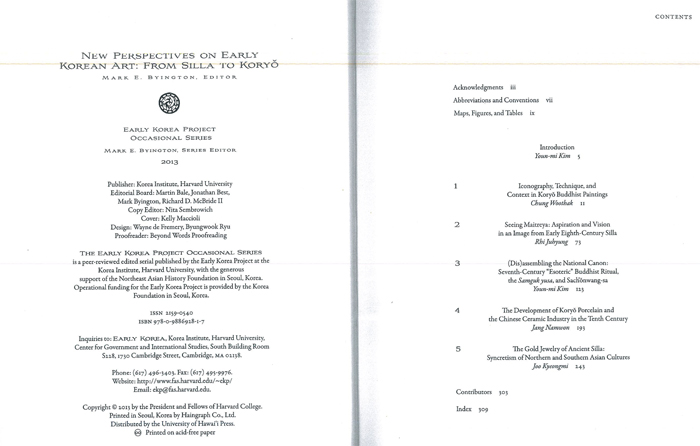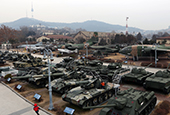-
 Korea.net's 24-hour YouTube channel
Korea.net's 24-hour YouTube channel- NEWS FOCUS
- ABOUT KOREA
- EVENTS
- RESOURCES
- GOVERNMENT
- ABOUT US
Two English books on early Korean history were published by Harvard University on January 7. Titled “New Perspectives on Early Korean Art: From Silla to Koryo” and “The Han Commanderies in Early Korean History,” the two books are the fifth and sixth parts of a series published by the Korean History Institute at the U.S. university.
With this publication, the institute has now released a total of six English-language volumes as part of its “Early Korea Project,” sponsored by the Seoul-based Northeast Asian History Foundation.
The project kicked off in 2007 with the goal of bringing accurate facts about the early history of the Korean Peninsula to Western academia. Since its initiation, the project has covered workshops, lectures and publications.

The new books are a result of the institute’s ongoing efforts to publish more in English about Northeast Asian history.
The series is the result of a six-year study into early Korean history and consists of six books, including the two newly published ones. The four other volumes include “Reconsidering Early Korean history through Archaeology” published in 2008, “The Samhan Period in Korean History” and “State and Society in Middle and Late Silla,” both published in 2010, and “The Rediscovery of Kaya in History and Archaeology” published in 2012.
The fifth “New Perspectives on Early Korean Art: From Silla to Koryo” book looks at a variety of ancient relics from the period found in tumuli, or burial mounds, including everything from gold accessories through to Buddhist paintings.
It also provides deep insight into the social background and religious practices embedded in intangible cultural heritage items, and cross-cultural interaction amongst the peoples and regions of Korea, Manchuria, China, Japan, South and Southeast Asia during the era. The data were all obtained through exhaustive analysis of cultural legacies dating back to the Silla Kingdom (57 B.C.-A.D. 935) and the Goryeo Dynasty (918-1392).
The other new book and sixth in the series, “The Han Commanderies in Early Korean History,” deals with the most recent studies on the four commanderies established in 108 B.C. by Emperor Wu (r. 141 B.C.-87 B.C.) of the Han Dynasty of China (206 B.C.-A.D. 220). In particular, the locations and history of the four commanderies, often seen from either a Japanese or a Chinese perspective until now, are discussed in this book from the point of view of Korean academia.

“This series provides accurate facts on early Korean history to the Western academic world, for which much of this may have been quite unknown. It will help correct the existing distorted understanding about Northeast Asian history,” said an official from the Northeast Asian History Foundation in a statement.
By Sohn JiAe
Korea.net Staff Writer
jiae5853@korea.kr
With this publication, the institute has now released a total of six English-language volumes as part of its “Early Korea Project,” sponsored by the Seoul-based Northeast Asian History Foundation.
The project kicked off in 2007 with the goal of bringing accurate facts about the early history of the Korean Peninsula to Western academia. Since its initiation, the project has covered workshops, lectures and publications.

The six-volume series on the early history of the Korean Peninsula (Photo courtesy of the Northeast Asian History Foundation)
The new books are a result of the institute’s ongoing efforts to publish more in English about Northeast Asian history.
The series is the result of a six-year study into early Korean history and consists of six books, including the two newly published ones. The four other volumes include “Reconsidering Early Korean history through Archaeology” published in 2008, “The Samhan Period in Korean History” and “State and Society in Middle and Late Silla,” both published in 2010, and “The Rediscovery of Kaya in History and Archaeology” published in 2012.
The fifth “New Perspectives on Early Korean Art: From Silla to Koryo” book looks at a variety of ancient relics from the period found in tumuli, or burial mounds, including everything from gold accessories through to Buddhist paintings.
It also provides deep insight into the social background and religious practices embedded in intangible cultural heritage items, and cross-cultural interaction amongst the peoples and regions of Korea, Manchuria, China, Japan, South and Southeast Asia during the era. The data were all obtained through exhaustive analysis of cultural legacies dating back to the Silla Kingdom (57 B.C.-A.D. 935) and the Goryeo Dynasty (918-1392).
The other new book and sixth in the series, “The Han Commanderies in Early Korean History,” deals with the most recent studies on the four commanderies established in 108 B.C. by Emperor Wu (r. 141 B.C.-87 B.C.) of the Han Dynasty of China (206 B.C.-A.D. 220). In particular, the locations and history of the four commanderies, often seen from either a Japanese or a Chinese perspective until now, are discussed in this book from the point of view of Korean academia.

The contents page of “New Perspectives on Early Korean Art: From Silla to Koryo,” part of the Harvard series on the early history of the Korean Peninsula (Photo courtesy of the Northeast Asian History Foundation)
“This series provides accurate facts on early Korean history to the Western academic world, for which much of this may have been quite unknown. It will help correct the existing distorted understanding about Northeast Asian history,” said an official from the Northeast Asian History Foundation in a statement.
By Sohn JiAe
Korea.net Staff Writer
jiae5853@korea.kr
Most popular
- First hearing-impaired K-pop act hopes for 'barrier-free world'
- Event 'K-Beauty Hang Out' draws hundreds in Philippines
- Ceremony in Seoul inducts 2,641 content creators of Korean culture
- 'Mad Max' director impressed by 'cinema-literate' Korean viewers
- Cultural spring festival Seoul Festa to start on May 1















